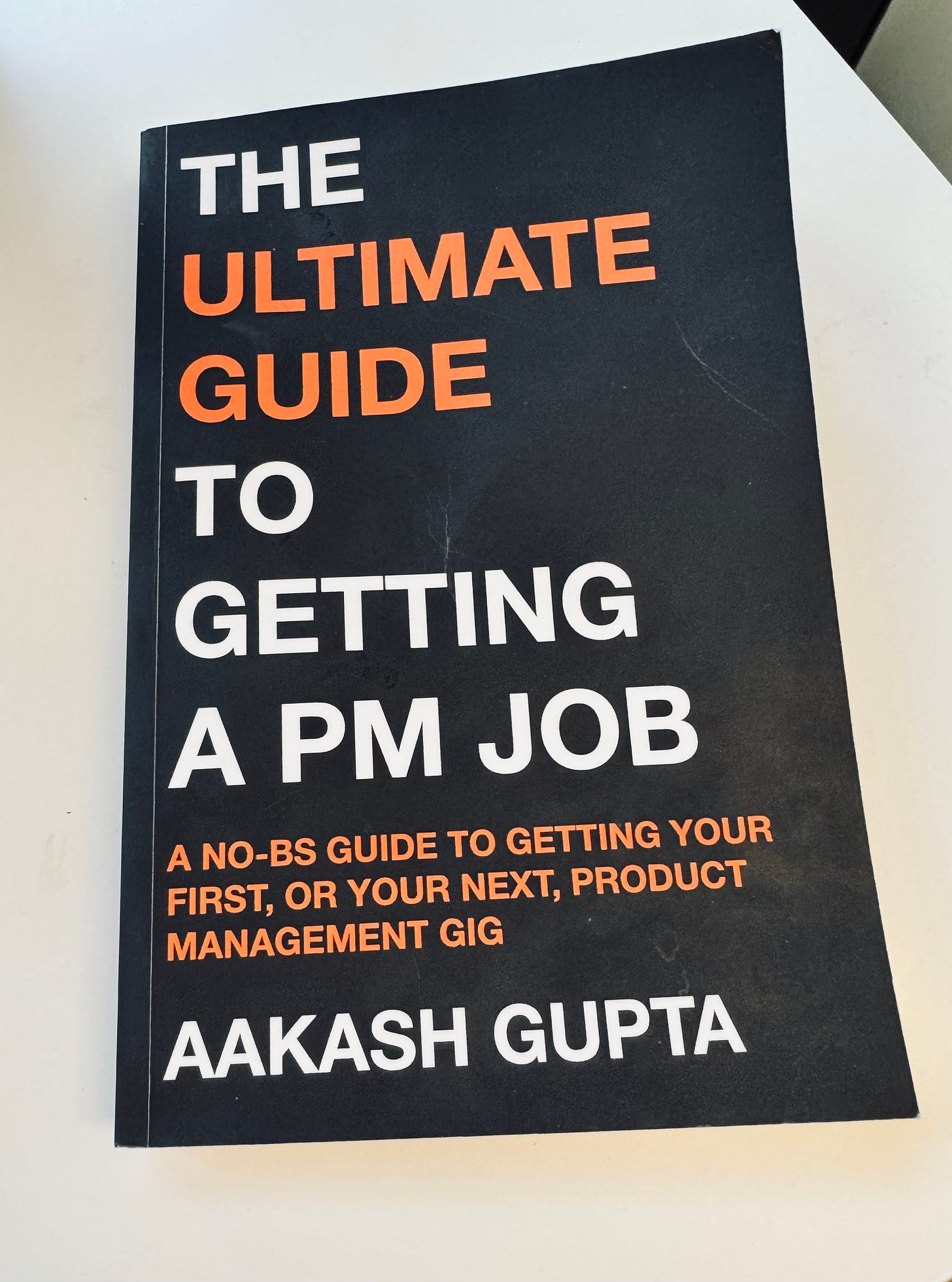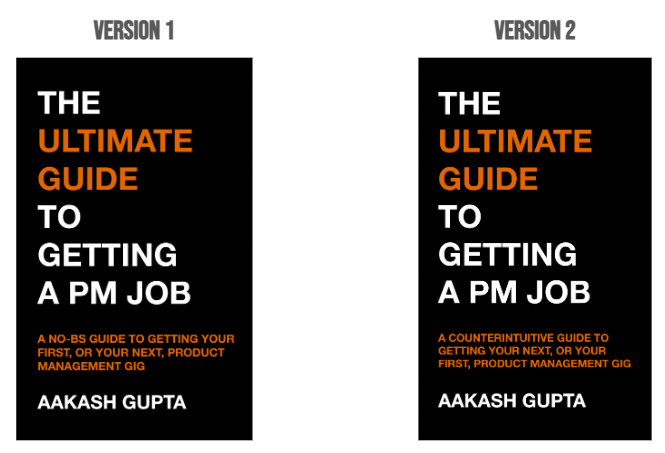Version 2: The Ultimate Guide to Getting a PM Job
Making Your 2024 Even More Successful
Version 2 of the book is here!
The book now covers:
How to get interviews
How to succeed in them
How to ace the homework
How to negotiate a great package
And it gives you an end-to-end framework to understand it all.
It’s the culmination of everything we’ve been talking about the newsletter in the last year.
It’s hard to compare computer screens to paper text.
So—this is for all those paperback book lovers like myself.
The Story of Version 2
I’ll admit it:
The reviews of version 1 weren’t up to my standard.
As a writer, I hope to create content that resonates and delivers 10x the value. A 4.0 rating on Amazon isn’t that.
When I look at other books with higher ratings, I know I can do better.
And I don’t want to give up paperback books. I just love holding and reading books.
In fact, I plan to write more of them.
So, as I wrote in The Product Growth Story of Product Growth, I have been working on an update for The Ultimate Guide to Getting a PM Job the past several months.
What I’ve really done is, I’ve followed the product process:
Customer discovery on the key problems
Dedicated time to rebuild key parts of the product
Iteration of the content to create a finessed version
I think that results in a version 2 that’s 10x better, but I’ll let you all be the judge of that.
This was my process.
1. Customer discovery on the key problems
Since the north star for version 2 of the book was improving my Amazon reviews, those were the primary source of data.
On Amazon, there were 5 main categories of complaints:
Hastily put together
Not enough getting a job content
Doesn’t have enough interview advice
Not enough depth and practical strategies
Links to templates that were hard to access
Feedback 1 - Hastily put together
This was one of the harder one’s to hear:
It feels hastily put together by someone trying to capitalize on their Linkedin Influencer fame
There was obviously roughness around the edges in the construction of the book. I hadn’t paid enough attention to all the details.
As I investigated with follow-up research, I found specifically:
There were a few places I removed a photo for copyright reasons but didn’t properly remove the reference in the text.
There were a few other places where it seemed like a newsletter article, instead of a chapter in a book.
Feedback 2 - Not enough getting a job content
This was by far the most common piece of advice, showing up in all of the reviews:
Two parts of the book are irrelevant to the name
I think a very small portion of the book actually focuses on getting the job
This was honest feedback too. The second two parts of the book are some of my most banger content…
But they aren’t directly relevant to the name and packaging of the book.
I learned a crucial lesson:
For books, your name is everything.
I probably should have known this. The same is true of newsletter and social media posts.
But I just missed the boat on the packaging in version 1.
Feedback 3 - Doesn’t have enough interview advice
In particular, one reviewer specified the exact content I was missing:
Not that much about interview process
Looking back at version 1, I see it.
There are so many different types of intimidating PM interview question types out there.
But just 5% of the book talked about them.
It needed to be more like 50%.
Feedback 4 - Not enough depth and practical strategies
I thought the content I did have was solid. But one reviewer disagreed:
Lacking depth and practical strategies. Its lack of credibility and generic advice make it a poor investment
While it hurt to read, on reflection, I figured out how I could make the depth and practical strategies much higher.
By:
Including more case studies
Having more word for word interview answers
Showing more examples of resumes, cover letters, and more
So, I validated this feedback area, as well.
Feedback 5 - Links to templates that were hard to access
The final area of feedback in the reviews was on the templates:
Unable to access the support material as these are on your substack
On investigation, I totally missed the packaging of the templates.
I needed to make them very easy to visit URLs that anyone could go to.
That was a miss.
Summary of the Review Discovery
Based on the reviews, I had a good sense of the major problems. When I investigated each problem, I more or less agreed with the criticism.
It reminded me a lot of my PM days on software products. The criticism is usually right.
The next step was to think through “the first principles why” of these problems. What happened?
I had basically chosen the wrong name for the book.
It’s information wasn’t all relevant to getting a job.
I wanted to include some fun things like History of PM, but since books are expensive, those were an unnecessary luxury.
This was the root cause of the problem.
Qualitative Chats
With a strong hypothesis on the overall problem, the next steps in discovery were for me to:
a. Have 1-hour chats with 3 friends who read the book
b. Ask feedback from 5 friends who read the book
These chats with others confirmed my initial findings.
One of my great advisors summarize the feedback thusly:
You got the packaging wrong. Two thirds of this book is teaching you about PM. So it doesn’t feel like it delivers on the promise.
It resonated with me.
Since my qualitative chats all were confirming those same 5 problems, I shifted a lot of chats to solution discovery.
This helped me sketch out some plans for what to improve.
Which is the subject of Section 2.
2. Dedicated time to rebuild key parts of the product
I realized I needed dedicated effort to:
Build out content for more getting the job content
Create dedicated time and space to work on the details
Make all the templates and other information really easy to access
My qualitative chats with people were confirming this solution direction. At this point, I felt pretty good about my problem and solution discovery.
Creating a Roadmap
So, I worked on the Table of Contents.
What would a new structure for the book look like?
See for yourself:
I got rid of sections 2 and 3, and really focused the book on a holistic process.
This new roadmap accomodated all the feedback.
And it became my new north star.
Executing on the Roadmap
Over the last 6 months, I worked with 10+ people on each of the chapters of the new book:
For the resume chapter, I worked with 10 subscribers on their resumes and implemented the successful tactics.
For the product sense chapter, I interviewed with 10 people who had recently passed the round.
And so on and so forth. All of the advice was market tested to ensure practicality and depth.
I didn’t just want to give advice. I wanted to give market tested advice specifically for PMs to show depth and specific insights.
Getting the Details Right
In my plan for addressing all Feedback areas 1-5, a lot of it comes down to details:
Hastily put together → Strong editing
Not enough getting a job content → Eliminated other sections
Doesn’t have enough interview advice → Made this 50% of the book
Not enough depth and practical strategies → Took a scalpel to anything not insightful
Links to templates that were hard to access → Made these super simple to access
I needed to get all the details, like template links right.
So I have paid extra care to that.
3. Iteration of the content to create a finessed version
I released the initial content for each chapter as newsletter issues.
This allowed me to get even further feedback on the concepts before adding them to the book.
I then created book chapters that were iterated upon:
Where newsletter subscribers said they ran into issues I modified the advice
Topics that people didn’t care about, I axed
The things that were typos that I missed, I fixed
So this has allowed me to create a truly tight and finessed version.
QA
In the first version of the book, I only had 1 editor: myself.
And it’s hard to edit your own writing.
For this second version, I’ve taken one additional step to finesse.
I got an editor. And I asked some family members to read it.
They pointed out things I missed.
So, this should make for a much cleaner, less seemingly hastily put together, product.
It’s just like software product QA: I did it more thoroughly, with more people.
Small Details of Edits
Here are a few of the smaller details that I’ve edited in this added finessing phase:
New font
New cover
New page numbers & headers
Removing areas of self-promotion
Being ruthless with any confusing phrasing
Lower price, with lower profit margins for me
Small Detail 1 - New Font
I love Sans Serif fonts like Arial on screens. They seem more modern. They have a cleanliness about them that works well on digital devices.
But they’re not as great on paper.
One quirk of the Amazon publishing program is you get the first copy of the book when customers do.
So when I got the first copy of the book, I realized that the Arial just isn’t as authoritative on paper.
On paper, the Serif fonts like Times Now Roman look more appropriate.
It’s perhaps because Times New Roman was created nearly 100 years ago. It fits the medium of paper better.
So I made the change from Arial to Times New Roman.
Small Detail 2 - New Cover
I like edgy writing, but “No-BS” didn’t get the message across for everyone.
I interviewed several folks who said they found it to not resonate, especially given the content.
My writing style is edgy, but it doesn’t use swear words.
My writing generally is surprising, not what people expect.
I decided a better word was counterintuitive:
So that was the front.
On the back, I’ve changed my own mugshot branding everywhere, so I updated that.
I also wanted to update the story about me and better reflect the new information the book contains:
I also made an edit to the Spine. I made the title thicker so it pops more in your bookshelf.
Overall, all the small details add up to a much better cover, if I do say so myself.
Small Detail 3 - New Page Numbers & Headers
Keep reading with a 7-day free trial
Subscribe to Product Growth to keep reading this post and get 7 days of free access to the full post archives.





